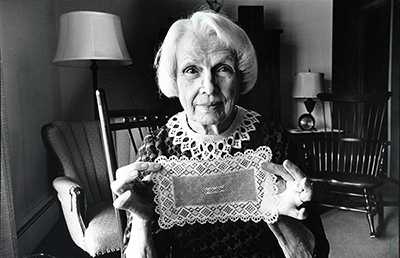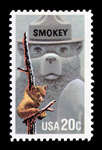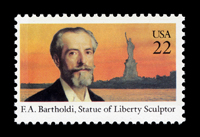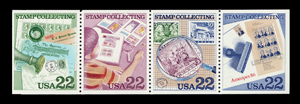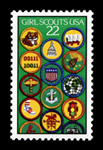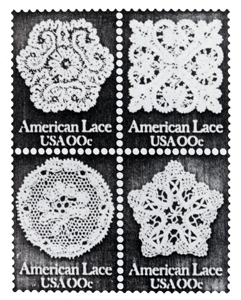American Philatelic |
1987 Lacemaking Stamps
The "Lacemaking" stamp set is the 8th subject issued in the ‘Folk Art Series’. Occasionally it is referred to as “Lacemaking in America”. Click here to see all the stamps in the Folk Art series. 163.98 million Lacemaking stamps were printed and distributed nationwide. The Lacemaking stamp initiative was driven by Mary McPeek (1909-2007) who was sometimes referred to as “Mother Mary” by USPS officials. She was strongly backed by the Michigan-based Great Lakes Lace Group (GLLG). Mary, who was a lace teacher and author in Ann Arbor, spearheaded the intensive petition drive for the stamp, which started around 1977. She obtained the support of Wilbur J. Cohen (1913-1987), a member of the Postmaster General’s Citizens' Stamp Advisory Committee and former US Secretary of Health, Education and Welfare under Johnson. He came to be known as "Mr. Lace" by the Committee for his advocacy of this stamp. Michigan Senator Carl Levin (1934-), himself a stamp collector, and Michigan Congressman William D. Ford (1927-2004) were also strong supporters. Mary McPeek recalls the experience in an article originally appearing in Piecework, May/June 1995, p. 64ff. The Committee made the decision to issue the stamp in 1984, after 7 years of lobbying effort. The Lacemaking stamp block design was unveiled on May 2, 1986, at the 10th anniversary convention of the Great Lakes Lace Group in the Hoyt Conference Center at the Eastern Michigan University in Ypsilanti. A luncheon followed the ceremony (June 1986 issue of the GLLG Newsletter). This was an unusual gesture by the Post Office since production problems had delayed the release, and once solved, there were further delays due to other stamps now ahead of them in the printing queue. The actual release occurred on August 14, 1987. This excerpt from an article in the September 1987 issue of American Philatelist, pp 827-282, summarizes the earlier production issues with this stamp:
One of the unsuccessful attempts is preserved in the Lacemaking stamp photoessay, which was often used directly in cachets (e.g., photoessay). The detail in this version is quite poor. The GLLG Newsletter of August 1987 contained extensive coverage of the August 14, 1987 dedication ceremony held at the McKenny Union on the Easter Michigan University campus, including the speech of USPS Consumer Advocate Ann Robinson, who did the actual dedication. She also described some of the problems involved in trying to make printing plates from the original photographs of the laces, and the eventual decision to do steel engravings to preserve the fine detail. There is also a hilarious account of GLLC members attempting to affix 20,000 stamps to 5,000 envelopes two days before the ceremony. So what was the real story? Not an entirely easy task given the length of time since 1987. I've consulted several specialists on the subject. As noted above, two different process were tried to print the stamp, both unsuccessful, and it is very possible in view of the failures that the whole attempt could have been abandoned. But in 1984 the Post office had installed a new machine, known as the USPS "D" press, (officially designated as press #902, and in use at the Washington Bureau of Engraving and Printing from 1984-1996). It was capable of producing stamps in a combination of up to six offset colors and three intaglio (engraved) colors in a single operation. This press was made by Goebel in Darmstadt, Germany, and cost $3.2 million. The D press was 'webfed', meaning it used a continuous roll of paper rather than individual sheets. You can see evidence of the path of the paper in the 'ink smear' pane in my collection. The D press had numerous startup problems which were not really solved until 1986. This can be illustrated by looking at some individual products: Another important factor going for the lacemaking stamp was the new emphasis on merchandising of bright, colorful stamps, although many traditional stamp collectors decried such commercialization as debasing their field. Nonetheless, when finally issued, the Lacemaking stamp was anticipated by the USPS to be extremely popular. The actual state of the craft of lacemaking in the US was not important. One measure of the truth of this prediction is the large number of cachet covers produced. The whole stamp merchandizing concept by the USPS gained much momentum in those years, and brought many new collectors to the field, just as the older purists were largely dying out.
All of the stamps show flowers native to the United States, although this was apparently not intentional. Trenna Ruffner from Grosse Pointe MI did the Honiton/Duchess dogwood design stamp (United States 2354). Her design is often referred to as “Honiton”. Ruth Maxwell from Dearborn interpreted a squash blossom design in point ground technique (United States 2351), although this stamp is often referred to as “Bucks Point”. Mary McPeek representing Ann Arbor used bobbinlace for the right-facing rose design, sometimes called ‘Applique Mixed Technique I’ (United States 2352). Lesli Saari from Cadillac used bobbinlace, needlelace and tatting to do the floral design sometimes called ‘Applique Mixed Technique II’ with the left-facing rose of basically the same design as the ‘Applique I’ piece (United States 2353). It seems that these last two artists based their final designs on same piece of lace that Libby Thiel had shown to the Committee. It is notable that although traditional techniques are used, the results are not strictly attributable to a specific European style, giving them an American flavor. The original pieces of lace were kept by the artists, and the Postal Museum in the Smithsonian accepted four other pieces of lace each made from elements of the original design. I have not been able to find the Smithsonian donations, which perhaps were never actually accomplished. Mary Liming McPeek's obiturary can be found at: http://www.dexterleader.com/stories/120607/obi_obits001.shtml. first posted 1/18/2009 |
|
References |






















































































